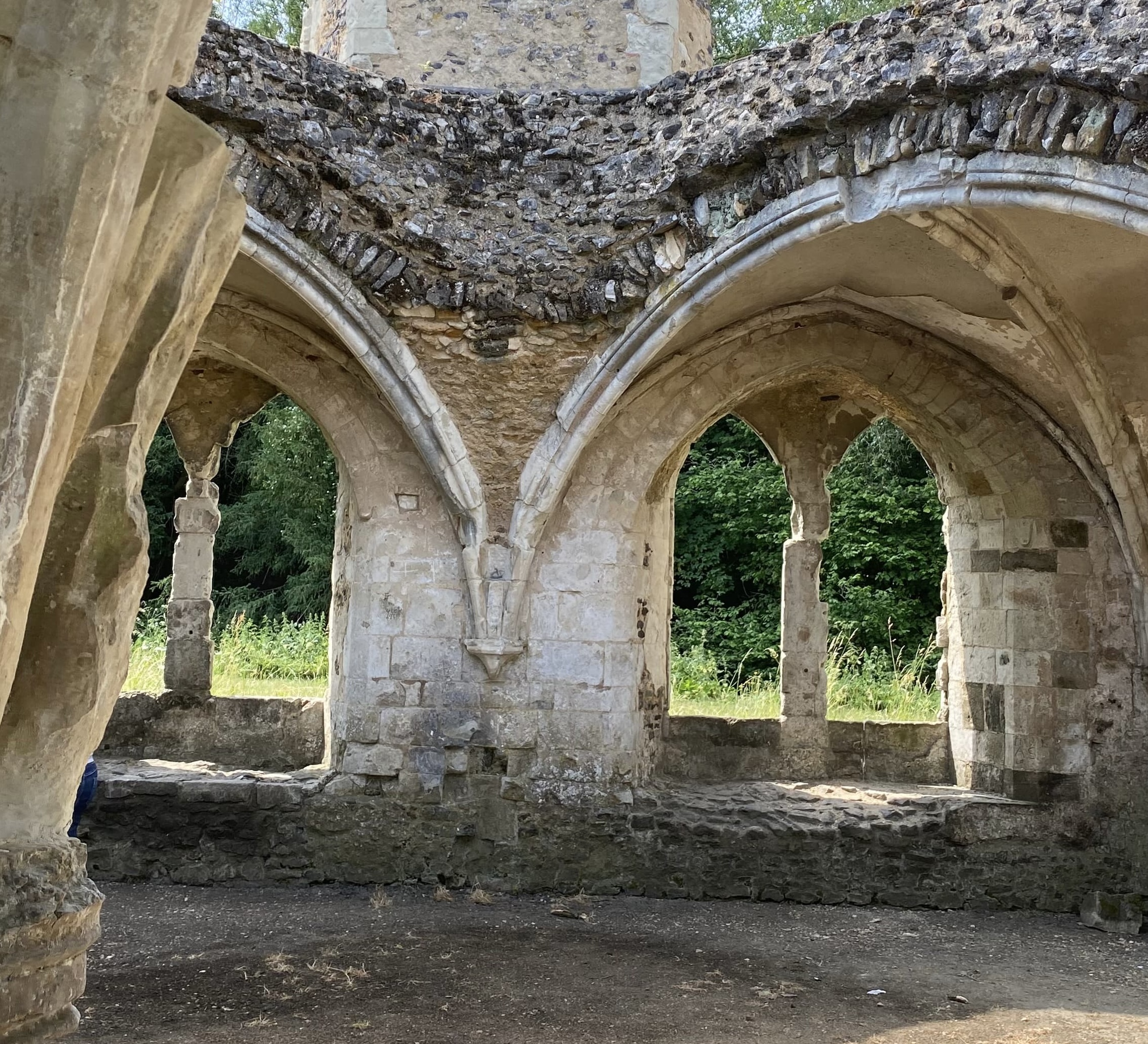Waverley Abbey is a film location for: Monks Barton Abbey in Monks Barton Wood („Talking to the Dead“), St Frideswide near Aspern Tallow („The Glitch“), Causton Abbey near Causton („The Ghost of Causton Abbey“).
Film Location for Midsomer Murders
The ruins of Waverley Abbey, the first Cistercian Abbey in England, have so far been used as a filming location for three episodes of our beloved series, namely
- Monks Barton Abbey (S11E07: Talking to the Dead)
- St Frideswide (S12E04: The Glitch)
- Causton Abbey (S20E01: The Ghost of Causton Abbey)
Let’s take a trip into the past of the first Cistercian monastery in England.
The History of Waverley Abbey

The Ruins of Waverley Abbey, June 2023. By Petra Tabarelli. Public Domain.
Situated near Farnham, in the middle of the idyllic countryside near the River Wey rise the ruins of the once glorious abbey, which is deeply rooted in the history of Great Britain. Founded in 1128 – 900 years ago – by William Gifford, the Bishop of Winchester, it was the first Cistercian monastery on British soil. The abbey was populated by a small community of 12 monks and an abbot from Aumone, France. However, this modest fledgling community quickly grew: by 1187, there were already 70 monks and 120 lay Cistercians living in the community, which followed the strict rhythm of Cistercian life.
The early history of the abbey is characterised by its benefactors, who enabled it to become one of the most important religious institutions in England. These benefactors included Adeliza, the wife of Henry I, and Henry III, who generously donated land to the abbey in 1239. But there were also times of misfortune. A devastating flood in 1201 destroyed large parts of the abbey buildings. It was not until 1278 that the new church, the foundation stone of which had been laid in 1203/4, was completed.
However, Waverley Abbey’s fate changed in the 13th century. During the reign of King John, it fell out of favour and support from the crown dwindled. The following centuries are shrouded in the mists of time, only sparsely documented, especially for the 15th and 16th centuries.
The Dissolution of the Monasteries
Life within the abbey walls was characterised by the strict Cistercian rule. The monks and lay brothers farmed the surrounding land, were involved in the wool trade and offered refuge to pilgrims. An infirmary was also run by the abbey, which looked after travellers and the sick. The architectural plan of the abbey followed the traditional guidelines of the Cistercian order. At the centre was the magnificent church, almost 91 metres long, surrounded by the important functional buildings. To the south of the church was the chapter house, where the monks met daily to hear a chapter of the order’s rules and discuss important matters.
With the Dissolution of the abbey in 1536, the once mighty monastery fell into the hands of Sir William Fitzherbert, the treasurer of the royal household. At a time when the dwindling power of the church was abandoning its stone monuments, the destruction of these venerable walls also began. Most of the abbey, which had once been a place of contemplation and prayer, was demolished. However, the stones, which had borne witness to centuries of history, found a new purpose. They were incorporated into the construction of Sir William More’s house in Loseley, a few kilometres to the east – a survival in a changed world in which the aristocracy claimed the remains of the monastic past for themselves. Thus the monastery, which had once been a centre of faith and power, was transformed into a silent memory, hidden within the walls of a manor house.
Silent Witness

Waverley Abbey in June 2023, by Petra Tabarelli. Public Domain.
The remains of Waverley Abbey tell a story that has dug deep into the earth and stone foundations. Between 1890 and 1903, excavations by the Surrey Archaeological Society opened a window into the past when they uncovered the full layout of the abbey. Today, the ruins are silent witnesses to a once important Cistercian abbey whose walls have long since succumbed to time. The stone was reused for the house at Loseley which is now Loseley Park.
The remains of the lay brothers’ house are the most impressive. Located at the rear of the site, graceful pillars rise up from the long cellar, supporting the vault that once housed the community of lay brothers. Parts of the south wall and the upper floor are still preserved, a last stand against the ravages of time. A solitary end wall sits nearby and is thought to have been part of the refectory where the friars ate their simple meals.
Waverley Abbey followed the strict, traditional plan of a Cistercian abbey. The large church, whose remains once guarded a sacred silence, measured almost 91 metres. To the south were the rooms that characterised the daily life of the monks: the chapter house, where they gathered to hear the rules of the order and discuss their business, the dormitory, where they found rest, and the refectory, which lay in the shadow of the cloister. The latrines and the lay brothers’ accommodation completed the austere, well-planned building. Read more on English Heritage.
English Heritage
Today, only fragments of these once monumental buildings remain: the remains of the chapter house, the monks’ dormitory, the lay brothers’ house, the presbytery and parts of the north and south transept. A vaulted crypt, in the early English style, still defies time and the elements. Nearby are the remains of a room with three pointed arched windows – perhaps the former refectory. Trees and ivy entwine the ruins, growing in and out of the walls, while the nearby river floods the land from time to time, soaking the ground that was once sacred.
Waverley Abbey has been on the National Heritage List since 20 November 1925 and is now being carefully restored by the Ministry of Works in an attempt to preserve the last stone witnesses to a glorious past.
Read more about Midsomer Murders & History
The Chronology of Midsomer County by Year or by Episodes
Deep Dives into Midsomer & History
This is an independent, non-commercial project. I am not connected to Bentley Productions, ITV or the actors.

First published on MidsomerMurdersHistory.org on 17 November 2024.
Updated on 12 November 2025.


[…] Midsomer, Waverley Abbey was used as a filming location for St Frideswide’s former abbey and it is this very ruin that […]
[…] In 1525 the monastery was dissolved by Cardinal Wolsey and transformed into Cardinal’s College with the Abbey Church as the college chapel. Funds from the dissolution of Wallingford Priory and other priories were used to dissolve Waverley Abbey. […]
[…] date and has been little altered externally since its construction in the 1560s. Stones from Waverley Abbey, which fell into ruin after the Dissolution of the Monasteries, were used in its construction […]
[…] once made a trip to Surrey. Loseley Park was built in the 16th century, partly with stones from Waverley Abbey after its Dissolution. By the time of the Domesday Book there was a building called Losele, owned […]
[…] Waverley Abbey, Waverley, Surrey […]
[…] take a look at the history of this manor, which is closely connected to the recently introduced Waverley Abbey. Why? Well this Tudor building was built partly from stones from the then recently dissolved […]
[…] Ruinen von Waverley Abbey, 51 km von Frilsham und 79 km von der Christ Church Cathedral in Oxford entfernt, wurden für […]
[…] Midsomer wurde Waverley Abbey als Drehort für St. Frideswide genutzt, und genau diese Ruine wird für die Außenaufnahmen von […]
[…] nach Surrey gemacht hat. Loseley Park wurde im 16. Jahrhundert gebaut, teilweise mit Steinen von Waverley Abbey nach deren Säkularisierung. Zur Zeit des Domesday Book gab es ein Gebäude namens Losele, das […]
[…] Zeit und wurde seit seinem Bau in den 1560er Jahren äußerlich kaum verändert. Steine der Waverley Abbey, die nach dem Säkularisierung der Klöster verfallen ist, wurden bei ihrem Bau verwendet – […]